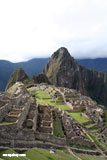

|
October 15, 2005
I will be out of contact for the next couple weeks. Updates will resume in early November. In the meantime, here are some popular articles from the past couple of months.
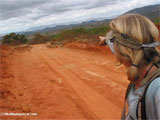
|

|
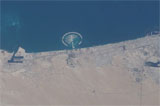
|

|
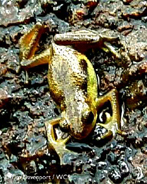
|

|
October 14, 2005
New research published in Molecular Ecology suggests that climate change could trigger the expansion of invasive species into wider ranges. The study looked at the genetic history of a goby species in the Eastern Atlantic which appears to have expanded its range dramatically when the world warmed about 150,000 years ago. The finding has broader implications beyond aquatic reef fish. Invasive species cause billions of dollars in damage per year. In the United States alone, the economic cost of invasive species -- in terms of the damage they do and the expense of controlling them -- is estimated at $137 billion a year, according to a study by Cornell University in 1999. Should global warming fuel the arrival of more non-native species, the cost -- both economic and ecological -- will likely rise as well.
"King Midas," a 300-pound (136 kg) green sea turtle, was the first animal returned to the Aquarium of the Americas in New Orleans after the facility was evacuated in the aftermath of Hurricane Katrina. Although the aquarium escaped the hurricane physically undamaged and had plenty of food and freshwater, virtually all of its 10,000 fish died when the facility's emergency generator failed and made conditions unlivable for most its animals.
October 13, 2005
Deforestation does not increase the risk of major floods according to a new report from the UN's Food and Agriculture Organization (FAO) and the Center for International Forestry Research (CIFOR). The study, citing evidence showing that the frequency and extent of major floods has not changed over the last century despite significant reductions in forest cover, challenges the conventional belief that forest loss causes floods. Instead, FAO and CIFOR say that deforestation does have a role in small floods and topsoil erosion. Further, the report accuses Asian governments of using deforestation as an excuse to deflect criticism over their poor handling of human settlement in areas unsuitable for habitation.
The Center for Tropical Forest Science at the Smithsonian Tropical Research Institute, which monitors millions of tropical trees across 15 countries, has announced a new director, Dr. Stuart Davies. Davies will spearhead the effort to continue research in topics relating to tropical forests including global carbon emissions, erosion and watershed management, biological interactions, biodiversity and biogeography, human resource use, and applied ecology.
October 12, 2005

|
October 11, 2005
There's at least a 25% chance of a magnitude 7.0 or greater quake occurring during the next 20 years in the San Francisco Bay Area according to a new computer simulation by researchers at the University of California, Davis. According to John Rundle, lead author of the study, the odds of an earthquake striking the Northern California region increase with time. "Virtual California," as the simulation is known, estimates that is a 50 percent chance of a magnitude 7.0 or greater on the San Francisco segment of the San Andreas fault in the next 45 years, and a 75 percent chance during the next 80 years. The US Geological Survey (USGS) projects 5,800 deaths from a magnitude seven in San Francisco.
The Amazon drought is worsening. Rivers in the region have fallen to the lowest levels on record, isolating communities and stalling commerce and transportation. At an ecological level, the drought has killed millions of fish, polluted drinking waters, and contributed to wildfires.
October 10, 2005
Scientists from New Mexico State University and Wake Forest University are working to develop organic solar cells. Unlike existing solar panels made of brittle silicon, organic solar cells are contructed of plastic that can be wrapped around structures or even applied like paint. This flexibility could revolutionize the solar market and help spur viability of alternative energy.
October 9, 2005
Engineers are working to use artificial tornados as a renewable energy source according to an article in last week's issue of The Economist. Storms release a tremendous amount of energy. Hurricane Katrina, a category 4 hurricane, released enough energy to supply the world's power needs for a year, while the typical tornado produces as much power as a large power station. Now engineers are attempting to harness some of this energy.
Scientists are using satellites to track salmon sharks that migrate from Alaska to Hawaii.
October 8, 2005
A female great white shark tagged in waters off South Africa has completed the first known transoceanic trip for an individual shark, traveling farther than any other shark known, more than 12,400 miles to the coast of Australia and back again, according to the Bronx Zoo-based Wildlife Conservation Society and other organizations in the most recent edition of the journal Science.
Another eco-friendly product has gone mainstream. Nestle, the world's largest food company, will introduce "fairtrade" coffee in British supermarkets within two weeks. The move comes shortly after Kraft partnered with the Rainforest Alliance to introduce its own environmentally-sound coffee, "Kenco Sustainable Development."
October 7, 2005
Google, AMD, Brightstar, News Corporation, and Red Hat have signed on to MIT's low-cost laptop initiative which aims to deliver a fully functional $100 machine to the developing world. MIT Media Lab is developing a Linux-based, full-color, full-screen laptop that will use innovative power sources -- including batteries or hand crank -- and will be able to do most everything that a standard laptop can do except store large amounts of data. MIT believes that laptops "are a wonderful way for all children to 'learn learning' through independent interaction and exploration," while development experts believe the laptop program could generate long-term economic benefits for some of the world's poorest people.
A coalition of 20 environmental groups sued the Bush administration Thursday to block road construction, logging and industrial development on more than 90,000 square miles of the nation's last untouched forests.
A new report from the World Bank says millions of deaths can be attributed to environmental factors, including climate change, pollution, unsafe water, poor sanitation and hygiene. These environmental conditions are significantly affecting health -- responsible for about a fifth of all ill health in poor countries -- and impeding economic development and growth. The report also links cancer to the environment.
October 6, 2005
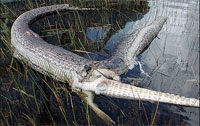
|
October 5, 2005
Heavy rains and mudslides from Tropical Storm Stan have killed at least 30 people in El Salvador. Widespread deforestation has worsened the impact of the storm by leaving barren hillsides vulnerable to mudslides and rivers susceptible to flooding. Tony Saca, El Salvador's president, estimates that "sixty-five per cent of the country is in danger of landslides."
I am moving Mongabay.com to a new set of servers so please excuse any access issues you may encounter over the next 3-4 days. Once the transition is made, the site will have about 20 times the current capacity. Last month's traffic pushed the limits of the existing system.
October 4, 2005
High gas prices caused American consumers to spurn sport-utility vehicles in September. Further, resale values for SUVs are falling as demand for the gas-guzzling vehicles softens while interest in smaller, more fuel-efficient models soars. According to The Wall Street Journal and Autodata Corp., U.S. car and light-truck sales fell 7.6% in September. The September sales figures are the best evidence to date that consumers are looking for more fuel-efficient vehicles as gasoline prices have climbed past $3 per gallon.
A new study conducted by researchers at Children's Hospital & Research Center Oakland is the first to discover that a chemical in cocoa beans can limit the development of fluids that cause diarrhea. Cocoa beans contain a large amount of chemicals called flavonoids which can be used to create natural supplements to ease diarrhea symptoms. Flavonoids can also provide cardiovascular benefits according to a study released this week.
October 3, 2005
Yesterday The Independent carried a travel journal of Richard Reed, owner of Innocent smoothies, that detailed Greenpeace operations in the Brazilian Amazon. Greenpeace has become a favorite target of local land developers and today activists travel in bullet-proof cars and wear protective vests after several assassination attempts.
Sea turtles have temporarily lost protection in wake of Hurricane Katrina. The National Marine Fisheries Service has granted shrimp trawlers a temporary 30-day exemption from federal Turtle Excluder Device (TED) requirements in certain state and federal waters off Alabama, Mississippi and Louisiana. Turtle Excluder Devices protect sea turtles and other large marine animals from being captured in trawl nets. The exemption from federal TED requirements is currently set to expire at 11:59 pm on October 22, 2005.
To meet Kyoto protocol commitments, European governments are encouraging the use of biofuels in transport and electricity. While biofuels are often lauded as green sources of energy, problems arise when wildlands are cleared for the specific purpose of growing biomass as is the case with oil palm in southeast Asia and soybeans in Amazon region of South America. Glenn Barry of Forests.org has asked for support in delivering a message to the European Commission on the use of such biofuels at the expense of wildlands.
October 2, 2005
Two Duke University physicists report that at least 10 to 30 percent of global warming measured during the past two decades may be due to increased solar output rather than factors such as increased greenhouse gas emissions. The physicists said that their findings indicate that climate models of global warming need to be corrected for the effects of changes in solar activity. However, they emphasized that their findings do not argue against the basic theory that significant global warming is occurring because of carbon dioxide and other "greenhouse" gases.
A new weapon in the battle against HIV may come from an unusual source -- a small tropical frog. Investigators at Vanderbilt University Medical Center reported this month in the Journal of Virology that compounds secreted by frog skin are potent blockers of HIV infection.
October 1, 2005
The Amazon River in Peru is at its lowest level in 30 years of record keeping according to a report in Peruvian daily newspaper El Comercio. Local officials say deforestation is the likely culprit of the low water levels. While variable water levels are characteristic of the Amazon river ecosystem, the increasingly extreme fluctuations are of great concern.
For the first time ever, scientists have observed and photographed wild gorillas using tools, in one instance employing a stick to test the depth of a pool before wading into it, according to a study by the Bronx Zoo-based Wildlife Conservation Society (WCS) and other organizations. Up to this point, all other species of great apes, including chimpanzees and orangutans, have been observed using tools in the wild, but never gorillas.
September 30, 2005
The likely source of SARS -- which killed 770 people in 2003 -- is the horseshoe bat, a new study in the journal Science suggests. Now that a bat has been identified as the origin for the respiratory disease, there is concern that all bats will be persecuted. This would be a shame. Not only do bats play a crucial role in the health of ecosystems but they are also helpful in controlling insects, including malaria-carrying mosquitoes.
Over the past few days a series of Arctic-related studies have been released. A report in Nature says rising carbon dioxide in the atmosphere could make oceans too acidic for marine organisms producing protective shells. Such a development could be catastrophic for the ocean's food chain and devastating for world fisheries. Another study, published in the August 2005 issue of the NRC Research Press' Canadian Journal of Forest Research, reports that climate change causing ancient lakes and wetlands in Alaska to be replaced by forest. Finally, the National Snow and Ice Data Center announced that summer Arctic sea ice coverage has fallen far below average for fourth straight year.